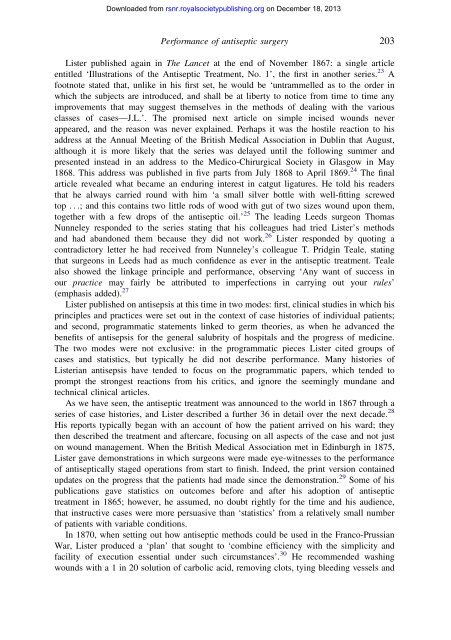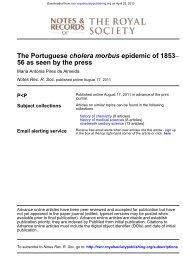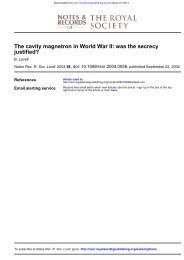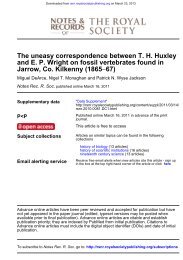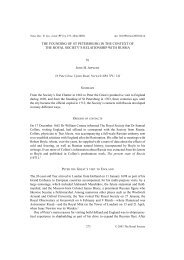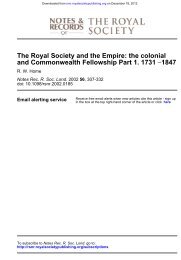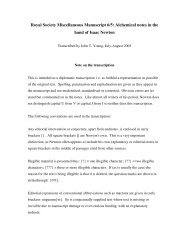JOSEPH LISTER AND THE PERFORMANCE OF ANTISEPTIC ...
JOSEPH LISTER AND THE PERFORMANCE OF ANTISEPTIC ...
JOSEPH LISTER AND THE PERFORMANCE OF ANTISEPTIC ...
You also want an ePaper? Increase the reach of your titles
YUMPU automatically turns print PDFs into web optimized ePapers that Google loves.
Downloaded from rsnr.royalsocietypublishing.org on December 18, 2013<br />
Performance of antiseptic surgery 203<br />
Lister published again in The Lancet at the end of November 1867: a single article<br />
entitled ‘Illustrations of the Antiseptic Treatment, No. 1’, the first in another series. 23 A<br />
footnote stated that, unlike in his first set, he would be ‘untrammelled as to the order in<br />
which the subjects are introduced, and shall be at liberty to notice from time to time any<br />
improvements that may suggest themselves in the methods of dealing with the various<br />
classes of cases—J.L.’. The promised next article on simple incised wounds never<br />
appeared, and the reason was never explained. Perhaps it was the hostile reaction to his<br />
address at the Annual Meeting of the British Medical Association in Dublin that August,<br />
although it is more likely that the series was delayed until the following summer and<br />
presented instead in an address to the Medico-Chirurgical Society in Glasgow in May<br />
1868. This address was published in five parts from July 1868 to April 1869. 24 The final<br />
article revealed what became an enduring interest in catgut ligatures. He told his readers<br />
that he always carried round with him ‘a small silver bottle with well-fitting screwed<br />
top ...; and this contains two little rods of wood with gut of two sizes wound upon them,<br />
together with a few drops of the antiseptic oil.’ 25 The leading Leeds surgeon Thomas<br />
Nunneley responded to the series stating that his colleagues had tried Lister’s methods<br />
and had abandoned them because they did not work. 26 Lister responded by quoting a<br />
contradictory letter he had received from Nunneley’s colleague T. Pridgin Teale, stating<br />
that surgeons in Leeds had as much confidence as ever in the antiseptic treatment. Teale<br />
also showed the linkage principle and performance, observing ‘Any want of success in<br />
our practice may fairly be attributed to imperfections in carrying out your rules’<br />
(emphasis added). 27<br />
Lister published on antisepsis at this time in two modes: first, clinical studies in which his<br />
principles and practices were set out in the context of case histories of individual patients;<br />
and second, programmatic statements linked to germ theories, as when he advanced the<br />
benefits of antisepsis for the general salubrity of hospitals and the progress of medicine.<br />
The two modes were not exclusive: in the programmatic pieces Lister cited groups of<br />
cases and statistics, but typically he did not describe performance. Many histories of<br />
Listerian antisepsis have tended to focus on the programmatic papers, which tended to<br />
prompt the strongest reactions from his critics, and ignore the seemingly mundane and<br />
technical clinical articles.<br />
As we have seen, the antiseptic treatment was announced to the world in 1867 through a<br />
series of case histories, and Lister described a further 36 in detail over the next decade. 28<br />
His reports typically began with an account of how the patient arrived on his ward; they<br />
then described the treatment and aftercare, focusing on all aspects of the case and not just<br />
on wound management. When the British Medical Association met in Edinburgh in 1875,<br />
Lister gave demonstrations in which surgeons were made eye-witnesses to the performance<br />
of antiseptically staged operations from start to finish. Indeed, the print version contained<br />
updates on the progress that the patients had made since the demonstration. 29 Some of his<br />
publications gave statistics on outcomes before and after his adoption of antiseptic<br />
treatment in 1865; however, he assumed, no doubt rightly for the time and his audience,<br />
that instructive cases were more persuasive than ‘statistics’ from a relatively small number<br />
of patients with variable conditions.<br />
In 1870, when setting out how antiseptic methods could be used in the Franco-Prussian<br />
War, Lister produced a ‘plan’ that sought to ‘combine efficiency with the simplicity and<br />
facility of execution essential under such circumstances’. 30 He recommended washing<br />
wounds with a 1 in 20 solution of carbolic acid, removing clots, tying bleeding vessels and


